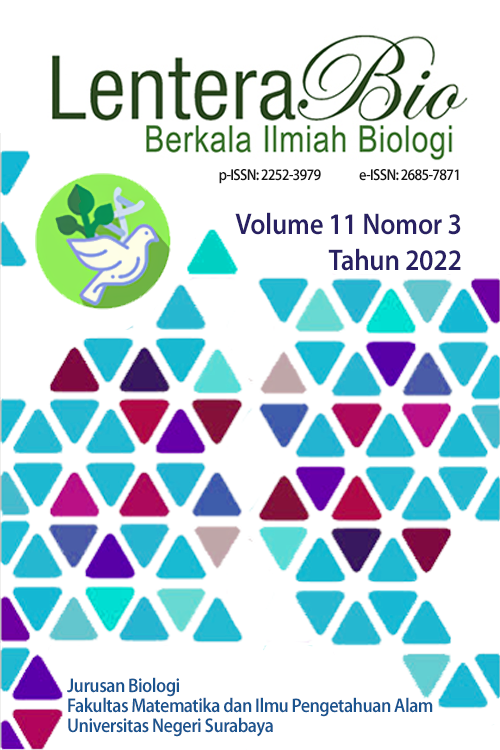The Effect of Earthworm (Eudrilus eugeniae) Powder on Blood Glucose Levels and Langerhans Islets Profile of Diabetic Mice (Mus musculus)
DOI:
https://doi.org/10.26740/lenterabio.v11n3.p525-535Keywords:
Reactive Oxygen Species, Diabetes mellitus, Eudrilus eugeniae, Wide of Langerhans IsletsAbstract
One of the causes of diabetes mellitus is oxidative stress which trigger pancreatic ? cell damage. This study aims to determine the effect of Eudrilus eugeniae powder on blood glucose levels and Langerhans Islets profile in diabetic mice. The study used a completely randomized design with 6 treatment groups, namely negative control, positive control, glibenclamide, dose 1 (21064 mg/kgBW), dose 2 (28085 mg/kgBW), and dose 3 (42128 mg/kgBW), each with 4 repetitions. The mice were injected with alloxan to develop diabetes and treated orally for 14 days. The fasting blood glucose level (FBGL) of mice was measured on days 0, 7, and 15 of treatments. The Langerhans islets profile was determined based on the wide of ??the islets from pancreatic preparations with HE staining. FBGL data were analyzed using the Anova and Duncan tests. The islets wide data were analyzed using the Kruskal-Wallis and Mann-Whitney tests. The results of FBGL data analysis showed that on day 7, the negative control group was not significantly different with doses 1 and 2, but on day 15, only dose 1 showed similar results. The mean wide of ??Langerhans islets between each treatment groups showed significantly different (P < 0.05). Based on these results, it can be concluded that Eudrilus eugeniae worm powder has an effect on blood glucose levels and the profile of Langerhans islets with dose 1 is the most optimum.
Downloads
Published
How to Cite
Issue
Section
License
Copyright (c) 2022 LenteraBio : Berkala Ilmiah Biologi

This work is licensed under a Creative Commons Attribution-NonCommercial 4.0 International License.
Hak Cipta (c) LenteraBio: Berkala Ilmiah Biologi
Karya ini dilisensikan di bawah Lisensi Internasional Creative Commons Attribution-NonCommercial 4.0.
Pemberitahuan Hak Cipta.
Hak cipta dari artikel yang diterima untuk diterbitkan akan diberikan kepada jurnal sebagai penerbit jurnal. Hak cipta yang dimaksud meliputi hak untuk menerbitkan artikel dalam berbagai bentuk (termasuk cetak ulang). Jurnal mempertahankan hak penerbitan atas artikel yang diterbitkan.
 Abstract views: 724
,
Abstract views: 724
, PDF Downloads: 1334
PDF Downloads: 1334











